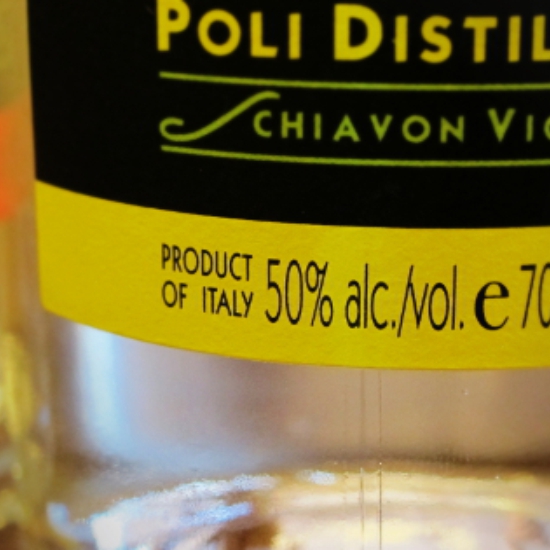The numbers of Grappa
The total number of Grappa producers in Italy is approximately 130 units. In the absence of certain data from official sources, it is estimated that around 63% of distilleries are located in the Northeast. Following this, the Northwest accounts for a significantly lower percentage, around 23%. In contrast, in the Center-South, just over 14% of companies are found. The majority of Grappa-producing distilleries are located in Veneto with 45 units, while 38 are in Trentino and 24 in Piedmont. The data from Tuscany, which has only 4, and Sicily, which has only 3, are surprising.
Alcohol Content, Taxation, and Excise Duty
In order to be released for consumption, Grappa must have an alcoholic strength (alcohol content) not less than alc. 37.5% vol. by volume (alc. 40% vol. for Grappas with Geographic Indication). The volumetric alcoholic strength is obtained through dilution with water, in accordance with the provisions of D.P.R. no. 236/88.
Grappa falls under the category of "spirits" and, as such, is subject to taxation by the State through excise duty on alcohol. The tax rate is based on the anhydrous liter, i.e., the unit of volume excluding water (the word anhydrous comes from Greek and means without water). Here's an example: a one-liter bottle of Grappa at alc. 40% vol. contains 1x40:100 = 0.4 liters of anhydrous alcohol, while the total liter of product is called hydrated liter. The amount paid to the State for each liter of anhydrous Grappa is €10.3552.
Grappa Formats
Almost entirely abandoning the 1-liter or 1.5-liter bottles, the most commonly used glass format for Grappa bottles is the 700 ml size. Half-liter and 100 ml formats are also very popular. Some producers are "reviving" the old 2 or 3-liter format, although it is almost exclusively directed at display purposes.
Alcohol Content, Taxation, and Excise Duty
In order to be released for consumption, Grappa must have an alcoholic strength (alcohol content) not less than alc. 37.5% vol. by volume (alc. 40% vol. for Grappas with Geographic Indication). The volumetric alcoholic strength is obtained through dilution with water, in accordance with the provisions of D.P.R. no. 236/88.
Grappa falls under the category of "spirits" and, as such, is subject to taxation by the State through excise duty on alcohol. The tax rate is based on the anhydrous liter, i.e., the unit of volume excluding water (the word anhydrous comes from Greek and means without water). Here's an example: a one-liter bottle of Grappa at alc. 40% vol. contains 1x40:100 = 0.4 liters of anhydrous alcohol, while the total liter of product is called hydrated liter. The amount paid to the State for each liter of anhydrous Grappa is €10.3552.
Grappa Formats
Almost entirely abandoning the 1-liter or 1.5-liter bottles, the most commonly used glass format for Grappa bottles is the 700 ml size. Half-liter and 100 ml formats are also very popular. Some producers are "reviving" the old 2 or 3-liter format, although it is almost exclusively directed at display purposes.
Production and Consumption
In 2022, the production landscape of Italian spirits saw significant growth, with a total of 95,410 hectoliters, representing a 10% increase compared to the previous year.
Grappa, in particular, saw a production of 83,000 hectoliters, marking a 12% increase compared to the previous year. However, these numbers are still lower than those recorded in the period 2012-2015.
In terms of consumption, Grappa has a solid base of enthusiasts in Italy. Recent data indicates that 30% of the population aged between 18 and 65 consumes Grappa, with 46% preferring to enjoy it in restaurants or bars. The tradition of enjoying it "neat" with friends is still widespread, but there is also a growing interest in experimenting with Grappa-based cocktails, with 35% of consumers interested in this consumption mode.
In addition to domestic consumption habits, Grappa is experiencing significant success in foreign markets. Between 2019 and 2022, Grappa exports grew by 32%, reaching a value of 60 million euros.
Countries like Germany, the United States, and Japan show significant interest in Italian distillate. In Germany, for example, Grappa exports account for 54% of the total market share, while significant increases in exports are recorded in the United States and Japan.
Grappa, in particular, saw a production of 83,000 hectoliters, marking a 12% increase compared to the previous year. However, these numbers are still lower than those recorded in the period 2012-2015.
In terms of consumption, Grappa has a solid base of enthusiasts in Italy. Recent data indicates that 30% of the population aged between 18 and 65 consumes Grappa, with 46% preferring to enjoy it in restaurants or bars. The tradition of enjoying it "neat" with friends is still widespread, but there is also a growing interest in experimenting with Grappa-based cocktails, with 35% of consumers interested in this consumption mode.
In addition to domestic consumption habits, Grappa is experiencing significant success in foreign markets. Between 2019 and 2022, Grappa exports grew by 32%, reaching a value of 60 million euros.
Countries like Germany, the United States, and Japan show significant interest in Italian distillate. In Germany, for example, Grappa exports account for 54% of the total market share, while significant increases in exports are recorded in the United States and Japan.



